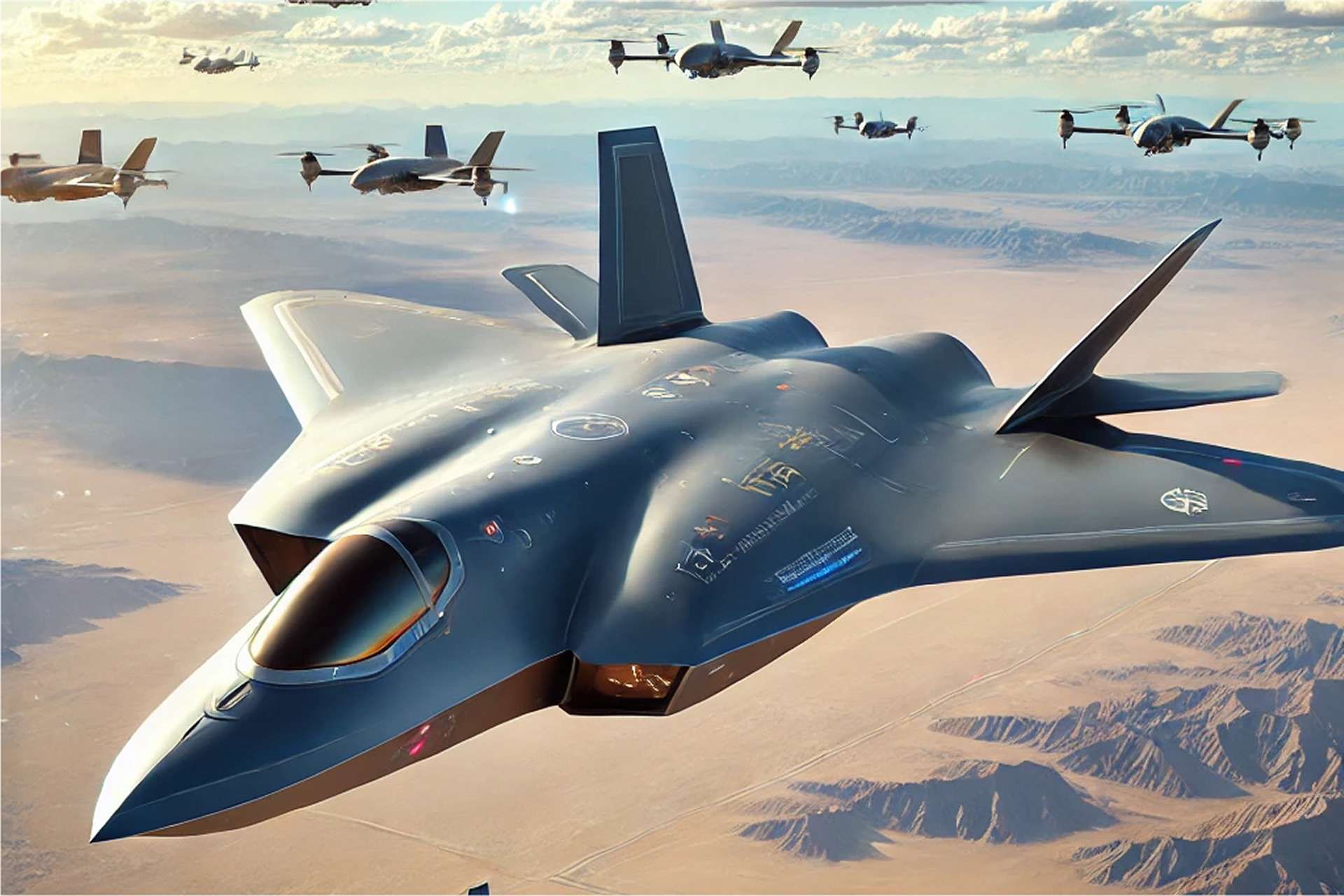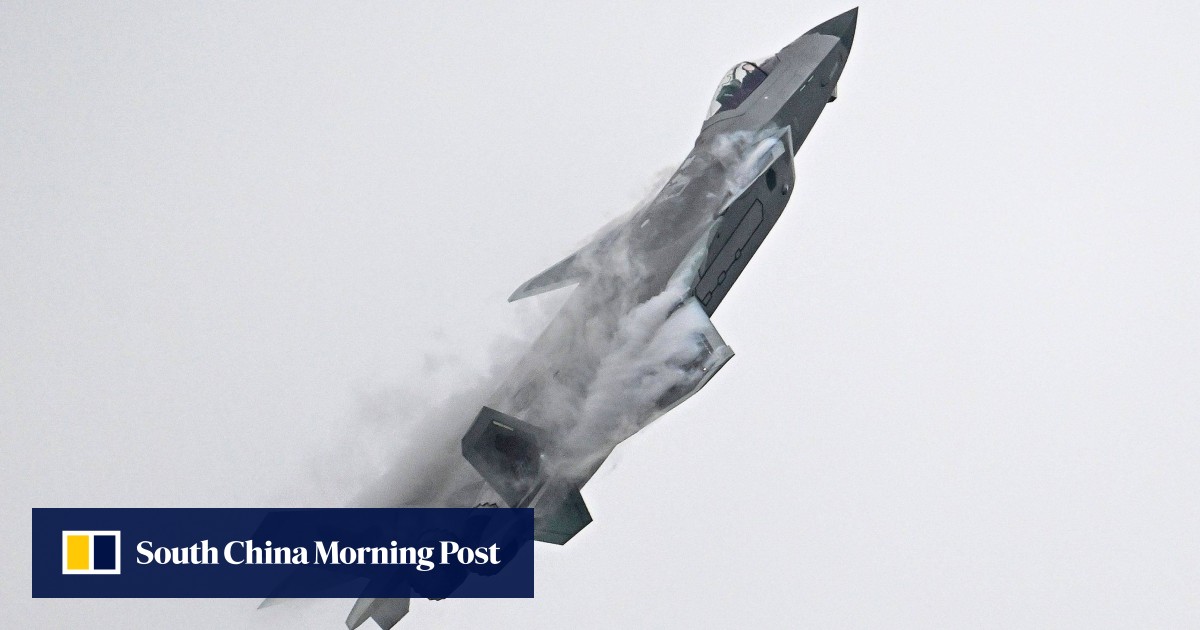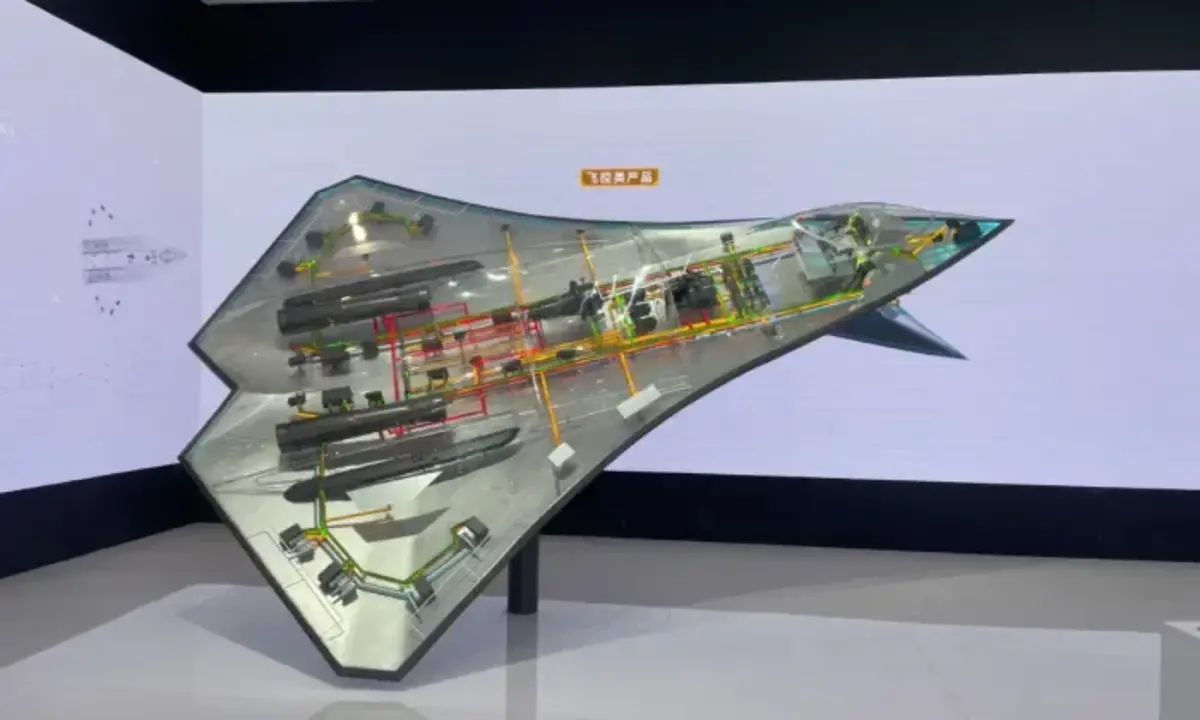China Reportedly Tested Advanced Fighter Jet with Detachable Drones
Defense News Aerospace 2024
According to the South China Morning Post, China has reportedly succeeded in testing a new aircraft that combines a stealth fighter with two detachable drones. This innovative design was demonstrated at an airport located at the southern edge of the Mu Us Desert in Ningxia, northwestern China. However, no photos of this aircraft have been obtained.
The stealth fighter, equipped with a twin-engine turbofan and an integrated fuselage with delta wings, executed a maneuver during the test flight.
- Segments of each wing detached from the main aircraft, transforming into two "flying wing" drones powered by electric fans.
- This information should be taken with caution as no images of this event have yet been shared.
According to Du Xin, a senior engineer at the Aeronautical Technology Institute of the China Aerodynamics Research and Development Center (CARDC), this successful test flight validates a new concept for the next-generation fighter of the Chinese Air Force. The design represents an advanced mode of collaborative manned/unmanned combat, integrating multiple aircraft with different functions for coordinated flight.
In an article published on May 29 in the Chinese journal Advances in Aeronautical Science and Engineering, Du and his colleagues explained that this approach addresses issues such as speed discrepancy and range incompatibility between manned and unmanned aircraft, achieving complementary advantages.
Yang Wei, the chief designer of the J-20 aircraft, mentioned that China's future stealth fighters will focus on combat alongside drones. The J-20, China's primary stealth fighter, is undergoing tests for a two-seater variant to enhance interaction capabilities with drones.
The next-generation stealth fighter design includes two drones attached to the trailing edge of the aircraft's delta wings. Unlike previous attempts to fix aircraft to the wingtips, Du's team adopted a "rear edge docking configuration," connecting the leading edges of the drones to the trailing edge of the main wing. This configuration allows for more stable flight but poses significant challenges due to drastic changes in the aircraft's center of gravity and focal point during separation.
Du's team developed a new algorithm to accurately analyze various disturbances, including wind changes, during separation. Both the jet and the drones use the FCC-100 flight control computer from Northwestern Polytechnical University, capable of complex calculations and reliable control.
The test flight date remains classified, but the project reportedly demonstrates advances in aircraft stability and control, paving the way for real-world applications. Chinese scientists are also exploring new technologies such as plasma stealth equipment and airflow for future fighters. However, as no official communication has been made public about the test, it is prudent to remain cautious about the veracity of this information, and we must wait for potential additional information from Chinese authorities.
The next-generation stealth fighter design includes two drones attached to the trailing edge of the aircraft's delta wings. Unlike previous attempts to fix aircraft to the wingtips, Du's team adopted a "rear edge docking configuration," connecting the leading edges of the drones to the trailing edge of the main wing. This configuration allows for more stable flight but poses significant challenges due to drastic changes in the aircraft's center of gravity and focal point during separation.
Du's team developed a new algorithm to accurately analyze various disturbances, including wind changes, during separation. Both the jet and the drones use the FCC-100 flight control computer from Northwestern Polytechnical University, capable of complex calculations and reliable control.
The test flight date remains classified, but the project reportedly demonstrates advances in aircraft stability and control, paving the way for real-world applications. Chinese scientists are also exploring new technologies such as plasma stealth equipment and airflow for future fighters. However, as no official communication has been made public about the test, it is prudent to remain cautious about the veracity of this information, and we must wait for potential additional information from Chinese authorities.
RELATED CONTENT UPLOADED ON THIS BLOG:
28 June 2024
China J-20 Stealth Fighter With Wingman Drones
The J-20 is China’s most potent stealth fighter, but a new aircraft under development could soon claim that title. Photo: CNS/AFP
Smooth test flight proves ‘new concept’ human-drone design for China’s next-gen fighter
- A new aircraft combining a stealth fighter with two drones that can break away in a flash is the latest weapon in China’s arsenal
Stephen Chenin Beijing
China unveils groundbreaking stealth fighter with drone integration in test flight
By Dimsumdaily Hong Kong
-11:26AM Fri June 28, 2024
28th June 2024 – (Ningxia) Chinese engineers and scientists have successfully conducted a test flight of a new stealth fighter jet, demonstrating advanced features that could redefine aerial warfare. The event took place at an undisclosed airport on the southern edge of the Mu Us Desert, showcasing a jet equipped with innovative drone integration technology.
The aircraft, distinguished by its blended wing body and delta wing design, is tailored for high-speed stealth operations. During the test, the jet exhibited a novel capability where segments of its wings detached to form two autonomous “flying wing” drones, powered by electric ducted fans. This transformation, however, initially caused a slight tremor in the fighter due to the sudden change in aerodynamics and centre of gravity.
Despite the initial instability, the main aircraft and the drones quickly stabilized, affirming the design’s aerodynamic efficiency and the robustness of its automatic control systems.
The aircraft, distinguished by its blended wing body and delta wing design, is tailored for high-speed stealth operations. During the test, the jet exhibited a novel capability where segments of its wings detached to form two autonomous “flying wing” drones, powered by electric ducted fans. This transformation, however, initially caused a slight tremor in the fighter due to the sudden change in aerodynamics and centre of gravity.
Despite the initial instability, the main aircraft and the drones quickly stabilized, affirming the design’s aerodynamic efficiency and the robustness of its automatic control systems.
This test marks a breakthrough in the “new concept” for the Chinese Air Force’s future fighter jets, aiming to enhance manned and unmanned collaborative combat capabilities.
Senior engineer Du Xin from the Aerospace Technology Institute at the China Aerodynamics Research and Development Centre (CARDC) highlighted the test’s success. According to Du, this integration allows for a coordinated operation between the manned jet and unmanned drones, effectively solving issues like speed mismatch and range limitations typically seen in standalone drone operations.
The peer-reviewed findings, published in the Chinese journal ‘Advances in Aeronautical Science and Engineering,’ detail the dual drone attachment at the rear edge of the jet’s wings, a strategic design choice by the CARDC team. This configuration not only aids in achieving aerodynamic stability but also presents a controlled environment even during the drones’ detachment.
Senior engineer Du Xin from the Aerospace Technology Institute at the China Aerodynamics Research and Development Centre (CARDC) highlighted the test’s success. According to Du, this integration allows for a coordinated operation between the manned jet and unmanned drones, effectively solving issues like speed mismatch and range limitations typically seen in standalone drone operations.
The peer-reviewed findings, published in the Chinese journal ‘Advances in Aeronautical Science and Engineering,’ detail the dual drone attachment at the rear edge of the jet’s wings, a strategic design choice by the CARDC team. This configuration not only aids in achieving aerodynamic stability but also presents a controlled environment even during the drones’ detachment.
China’s secret fighter jet’s wings transform into deadly drones midair
After some initial instability, all three of the aircraft were able to stay airborne under their own propulsion systems.Updated: Jun 28, 2024 05:57 AM EST
Christopher McFadden
7 hours ago

Stock image of one of China's J-20 stealth fighter in flight.
Wikimedia Commons
Chinese engineers have reportedly tested a new “combiner” blended-wing stealth aircraft with detachable drone wings.
Reminiscent of “combiner” or “mini-con” transformers from the 1980s and 1990s, the new stealth fighter-come-drone mothership was tested at an undisclosed airport on the southern edge of the Mu Us Desert.
In the event that some have called aerial warfare a “redefining” moment, if reports are true, the novel aircraft could indeed change aerial combat forever. The aircraft is said to stand out with its blended wing body and delta wing design, optimized for high-speed stealth operations.
Christopher McFadden
7 hours ago

Stock image of one of China's J-20 stealth fighter in flight.
Wikimedia Commons
Chinese engineers have reportedly tested a new “combiner” blended-wing stealth aircraft with detachable drone wings.
Reminiscent of “combiner” or “mini-con” transformers from the 1980s and 1990s, the new stealth fighter-come-drone mothership was tested at an undisclosed airport on the southern edge of the Mu Us Desert.
In the event that some have called aerial warfare a “redefining” moment, if reports are true, the novel aircraft could indeed change aerial combat forever. The aircraft is said to stand out with its blended wing body and delta wing design, optimized for high-speed stealth operations.
The J-20 stealth aircraft is a 5th-generation fighter aircraft developed by the Chinese People's Liberation Army Air Force (PLAAF). Imagine going with supersonic speed, accompanied with fleet of loyal wingmen drones above 60000 feet, how it will change the course of war. From highly sophisticated high altitude surveillance drones to attack drones that can use missiles and bombs to hit enemy targets.
#drones #chinaairforce #jet #fighterjet #stealth #wingman
00:00 Intro
02:20 1. Stealth technology:
02:40 2. Maneuverability
03:00 3. Armament
03:17 4. Avionics
03:33 5. Loyal Wingman concept
#fighterjet #fighter #chinaairforce #drones #aerialvehicle #militarydrones #wingman
The latest two seat J 20s, developed by China's Chengdu Aircraft Industry Corporation, has the ability to command combat multiple drones in coordinated missions.
the J 20 can effectively command multiple “loyal wingmen” stealth drones in complex operations.
In recent years, the United States, Russia and China have been actively building a combination of 6th generation stealth fighters to work in tandem with loyal wingmen, But China appears to be making the fastest progress.
US F-22, F-35 and Russian SU-57 fighter jets do not yet have the two-seat version, nor the capability to operate in conjunction with drone’s fleet.
The J 20s has not just added a pilot, but data the information capability have made a huge leap in battlefield situational awareness.
That is why it needs two pilots, because the new improved radar and photoelectric systems datalink the battlefield awareness data processing system can be better collected, processed and outputted.
This also required a second pilot for the J 20 be able to better manage the massive increase in data collected by J-20 itself and loyal wingmen.
Here are some key points about the J-20 and its accompanying "loyal wingman" concept:
1. Stealth technology: The J-20 is designed with advanced stealth technology, making it difficult to detect by radar. The aircraft's shape and composition are optimized to reduce its radar signature, making it harder for enemy forces to track and engage.
2. Maneuverability: The J-20 is highly maneuverable, thanks to its aerodynamic design and powerful engines. It can fly at supersonic speeds and perform complex aerial maneuvers, making it a formidable opponent in air-to-air combat.
3. Armament: The J-20 is equipped with a variety of advanced weapons, including air-to-air missiles and air-to-surface missiles. It also has an internal cannon for close-range engagements.
4. Avionics: The J-20 is equipped with advanced avionics, including a radar system that can track multiple targets at once, as well as advanced communication and navigation systems.
5. Loyal Wingman concept: The loyal wingman concept involves pairing the J-20 with unmanned aircraft that can operate as "wingmen" to the main fighter. These unmanned aircraft can perform a variety of tasks, including reconnaissance, electronic warfare, and even offensive operations. The J-20 can control these wingmen, allowing for more coordinated and effective operations. Drones can perform the most dangerous tasks such as going deep into an enemy's well protected area to find out what's going on, or dogfighting with the enemy's most advanced stealth fighters, or flying closer to a target for reconnaissance.







No comments:
Post a Comment